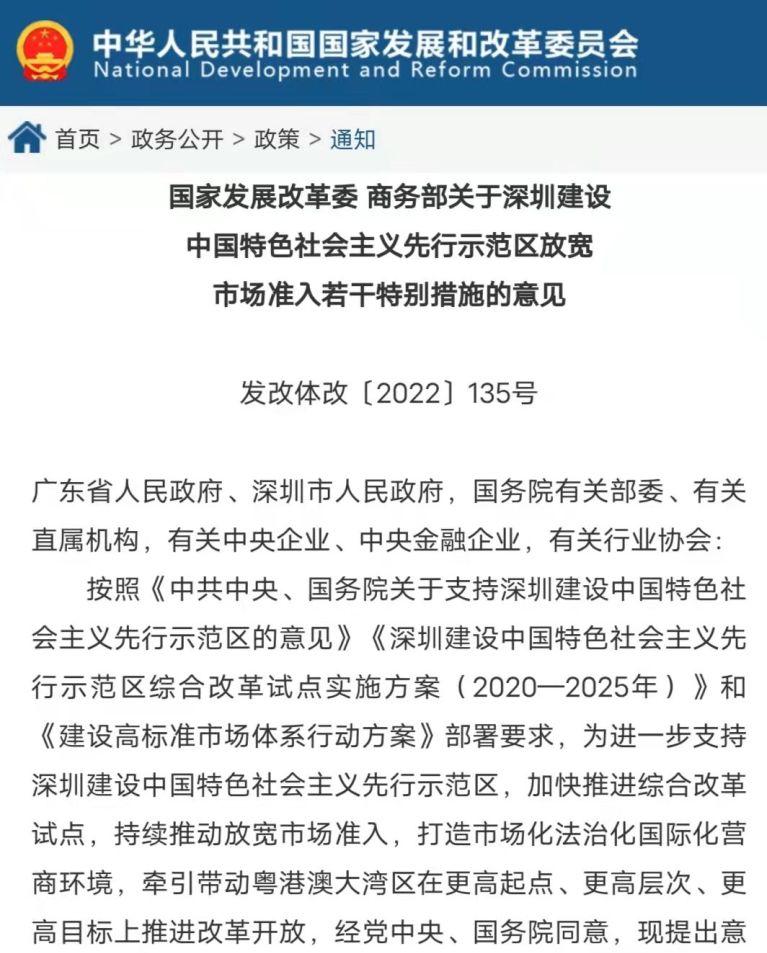On January 26, the National Development and Reform Commission and the Ministry of Commerce proposed in the "Opinions on Several Special Measures for Shenzhen to Build a Pioneering Demonstration Zone of Socialism with Chinese Characteristics to Relax Market Access" to support Shenzhen to carry out pilot reforms for the diversification of 5G indoor distribution systems, 5G industry virtual private networks and 5G network construction entities in specific regions. Safely and orderly open up basic telecommunications services, and support eligible satellite application enterprises to apply for satellite-related basic telecommunications business licenses or cooperate with enterprises with relevant qualifications.
At the same time, it will support communication operators in Shenzhen, Hong Kong and Macao to innovate communication products, reduce roaming communication tariffs and support the optimization of new generation information technology applications such as 5G and The Internet of Things. Relying on The Pengcheng Laboratory and other high-quality resources in Shenzhen to build a new generation of information technology distributed experimental platforms such as 5G and the Internet of Things.

In the industry's view, the above opinions will gradually reduce the entry threshold of new generation information technologies and new infrastructure such as 5G and Internet of Things in related fields. "And increased local competition to activate the vitality of the industry." Fu Liang, an expert in the telecommunications industry, told reporters.
At present, Guangdong has initially formed the world's largest 5G industry agglomeration area. Taking Shenzhen as an example, as of the end of October 2021, Shenzhen has built a total of 50,000 5G base stations, and the density of base stations has reached 24.68 per square kilometer, ranking first in the country. The Pengcheng Laboratory mentioned in the above-mentioned document is a new type of scientific research institution in the field of network communication approved by the central government, with network communication, cyberspace and network intelligence as the main research directions.
According to the information on the official website of Pengcheng Laboratory, the laboratory has 31 academicians, 200 international scholars and more than 3,000 national Jieqing and other high-end talents. Yu Shaohua, deputy director of Pengcheng Laboratory, said at a conference late last year that the internet has gradually become a "scene" anytime, anywhere, like sunlight, air, water and electricity. The network world has no quality, no substance, no boundary, cyberspace has become the focus of contention among countries, is the fifth frontier and strategic space of mankind after land, sea, air and space, and the right to control the network is equally important as the right to control the sea, the right to control the air, and the right to control the sky.
Taking satellite communications as an example, the above-mentioned document proposes to allow satellite application enterprises to carry out satellite mobile communication services and satellite fixed communication services nationwide. The industry believes that for the existing communications industry, this will stimulate the development speed of the satellite communication construction industry.
Huaxi Communications believes that in 2022, large-capacity (high-throughput) satellites will account for 50% of the total global satellite bandwidth, and around 2022, the demand for continental broadband satellite capacity will also reach more than 1TB, and the bandwidth cost will be greatly reduced to drive the popularization of applications.
However, from the perspective of global development trajectory, satellite launch models and manufacturing models are changing. Driven by Companies such as SpaceX, the manufacturing modes of rockets and satellites have changed from traditional customization to batch, and the cost of traditional launch manufacturing has been greatly reduced. According to the latest data from SpaceX, as of January 18, 2022, Musk's Starlink program has launched a total of 2,042 satellites, and 1,700 are already in operation, far more than any other agency and entity, and its long-term planning is to launch 42,000.
In addition, in the international market, the layout of satellite Internet companies not only have professional space operation companies, but also include Internet giants such as SoftBank, Google, Facebook, airlines such as Airbus and Boeing, and giants in other fields such as Qualcomm and Coca-Cola, and all kinds of capital participate actively.
At present, the mainland is also promoting the development of high-orbit satellites and low- and medium-orbit satellites. CITIC Securities said that the mainland has launched a low-orbit constellation plan since 2015, and constellations including Hongyan, Hongyun and Galaxy plan to launch more than 3,000 satellites in low-Earth orbit.
It is worth noting that on January 18 this year, 6 low-orbit broadband communication satellites independently developed by Galaxy Aerospace were officially shipped out of the factory, which is the first batch development of low-orbit broadband communication satellites by the mainland. At present, the satellites have arrived at the launch site and are scheduled to be launched by the Long March 2C carrier rocket in the first quarter of 2022. After the successful launch, a satellite Internet test network will be built, which can realize continuous communication services for more than 30 minutes at a time.